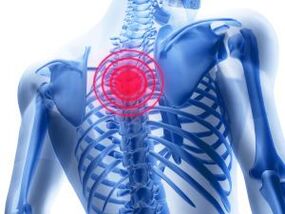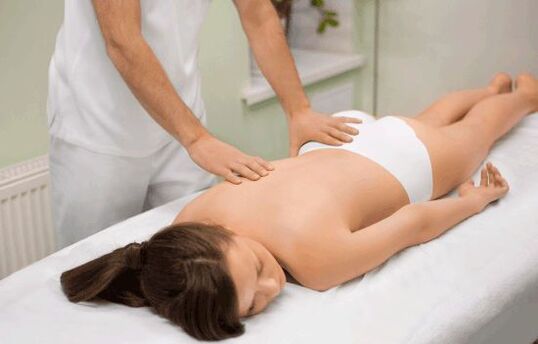
Clinically, thoracic osteochondrosis (chondrosis) is manifested by sharp, stabbing or dull pain, snapping and snapping when bending, stiffness.
For the pathology, the characteristic and numerous specific symptoms are sensation of shortness of breath when breathing in, discomfort in the heart region and even sore throat.
The treatment of the pathology is predominantly conservative with pharmacological drugs. Physiotherapy procedures, massage sessions and use of chiropractors are also performed.
If such treatment is ineffective, the patient is shown surgical intervention.
Symptom Details
The symptoms of osteochondrosis of the thoracic spine never appear all at once. In the early stage of development of this dystrophic degenerative condition, only mild back discomfort is noted. Patients take them for trivial fatigue after a hard day's work, cancel out the "numb" muscles due to a long stay in one body position.
But the intensity of the discomfort is slowly and steadily increasing. Unpleasant sensations are replaced by severe pain, complicated by limited range of motion, dizziness, and headaches. In medicine, all osteochondrosis symptoms of a particular location are divided into several groups. This helps to diagnose faster and determine treatment tactics.
On a note!The symptoms of thoracic osteochondrosis in men and women do not differ in character, severity, or location. But in stronger sex, they can appear a little later due to the stronger musculoskeletal system. Also, some men have erectile dysfunction in the context of osteochondrosis.
vertebral symptoms
Under the influence of unfavorable factors (hypothermia, increased physical activity), a long-term remission of thoracic osteochondrosis can be interrupted by a sudden onslaught of acute pain. Even more often, it is caused by a long stay in one body position, for example, in a sitting position. If a person stands up abruptly, the back pain is so severe that he loses the ability to move for several minutes.
In medicine, this condition is called the back. It differs from common pain in concomitant symptoms:
- a feeling of shortness of breath when inhaling;
- severe stiffness.
The course of the pathology is usually complicated by back pain - pain in the thoracic spine, which gradually increases in intensity. Increases with flexion, turning the body sideways. In order not to feel pain, the person assumes a forced position. At the same time, it unintentionally strains the back muscles, unintentionally causing them to strain. Now they also start to hurt, especially when walking.
extravertebral symptoms
As thoracic osteochondrosis develops, the intervertebral discs become thinner and destroyed. These cartilaginous pads can no longer distribute the resulting loads, they exclude the impact of the vertebrae against each other. A compensatory body response is triggered - bone structures begin to deform as growths form. They put pressure on sensitive nerve endings, interfere with the spinal canal. Therefore, there are specific symptoms of thoracic osteochondrosis in women and men: loss of sensation in certain parts of the body, burning sensation and chills.
Important! Osteochondrosis of the thoracic location is often manifested by dry, unproductive cough, sore throat, feeling of coma, as well as urinary disturbances.
But that is not all. The spinal roots are responsible not only for the innervation (transmission of nerve impulses) to the spine, but also for the internal organs. Therefore, when they are infringed, uncomfortable sensations arise in the liver, kidneys, digestive tract, myocardium. What are the non-characteristic signs of back pathologies manifested by thoracic osteochondrosis:
- pain in the heart region, identical to the recurrence of angina pectoris, shortness of breath, feeling of "squeezing" of the heart;
- panic attacks, psycho-emotional instability, irrational fear, anxiety, sleep disturbances;
- discomfort in the epigastric region, bouts of nausea, sometimes leading to vomiting, sour belching, swelling, boiling, and rumbling;
- peristaltic disorders - constipation or diarrhea;
- lingering and difficult breaths with hiccups.
The pains are not located directly at the site of the destroyed intervertebral disc and (or) the formed intervertebral hernia. They radiate along the nerve course. Signs of osteochondrosis in the thoracic region can be disguised as renal colic, symptoms of gastritis, gastric ulcers, hepatitis, pancreatitis, cholecystitis and even gastroenteritis.
compression myelopathy
This is the name of extravertebral syndrome, which is rarely seen in clinical practice. It is seen in 3-4 stages of the disease, when, due to loss of stability by the vertebral segment, the nucleus pulposus projects beyond the annulus fibrosus. An intervertebral hernia forms, constantly putting pressure on the spinal cord. In an appointment with a vertebrologist or neurologist, patients complain of frequent pain in the waist that radiates to the groin area. At the same time, there are feelings of weakness and numbness in the lower extremities.
In the context of spinal cord violation, the innervation is seriously disturbed. In the absence of treatment, the functional activity of organs located in the small pelvis decreases. Compression myelopathy causes problems with bowel movements. And due to the pronounced narrowing of the spinal canal diameter, the sensitivity of the legs decreases. In severe cases, patients are diagnosed with paresis (partial or complete paralysis) of one or two lower extremities.
remission symptoms
Apart from recurrences, chest osteochondrosis hardly bothers the person. Occasionally, there is a nagging, painful, and nagging pain in the back that usually goes away after a long rest. But it's worth increasing the load on the spine at least a little by lifting a heavy object or bending over, as the next relapse follows. It can be triggered by these factors:
- stressful situations, depressive states;
- hypothermia, sudden changes in temperature;
- prolonged stay in one body position;
- alcohol abuse;
- unbalanced diet, lack of foods rich in calcium, phosphorus, manganese, molybdenum in the diet.
Sometimes the remission stage ends because the person tries to avoid another relapse. He visits a chiropractor or massage therapist with a dubious reputation or little practical experience. An attempt to lengthen the spine leads to another exacerbation.
The main methods of treatment
It is not yet possible to completely cure the pathology, so all physicians' efforts are aimed at improving the patient's well-being. Patients are recommended to use orthopedic products (corsets, bandages), which fix the vertebral structures, preventing their displacement. Medicines from different clinical and pharmacological groups are prescribed, physical therapy measures are performed, and physical therapy exercises are performed.

The chiropractor's hand movements aim to increase the gaps between the vertebrae, which decrease in thoracic osteochondrosis.
Important!In severe thoracic osteochondrosis, conservative treatment is useless. Patients receive immediate surgical intervention - excision of an intervertebral hernia, arthrodesis, placement of implants in place of a damaged disc, bone graft.
drug therapy
The treatment of osteochondrosis of the thoracic spine aims at eliminating all symptoms, inhibiting destructive and degenerative processes. During periods of exacerbation, solutions for parenteral administration are used, which show effects after 5-10 minutes. Then, the result is consolidated with the completion of a course of preparations in tablets, application of ointments and gels. In the remission phase, external agents are mainly used, which have a milder effect on the body.
Non-steroidal anti-inflammatory drugs (NSAIDs)
This is the group of drugs most commonly used in the complex treatment of thoracic osteochondrosis. Its active ingredients block the biosynthesis of arachidonic acid pain, inflammation and fever mediators. Even after a single use of NSAIDs, a person's well-being improves significantly:
- the severity of the pain syndrome decreases;
- the unpleasant snap that occurs when the body turns and leans over disappears;
- the inflammatory processes in the soft tissues weaken, the edema disappears;
- range of motion in the thoracic region increases.
To stop relapses, intramuscular solutions are used. Capsule or tablet preparations can handle moderate pain. And ointments and gels quickly eliminate slight discomfort.
Preparations with B vitamins
Preparations with group B vitamins deal well with innervation disorders, improving the transmission of nerve impulses to the central and peripheral nervous system, stimulating the restoration of damaged spinal roots. The composition of the funds is represented by thiamine, riboflavin, pyridoxine, cyanocobalamin.
In the first week of therapy, intramuscular administration of drugs is practiced, which, in addition to vitamins, contain lidocaine, which instantly eliminates pain. And then, for a month, patients are shown taking pills.
Glucocorticosteroids
The use of these synthetic hormone analogues, which are produced by the adrenal glands, is practiced when the safest means are ineffective. Glucocorticosteroids are prescribed for patients with acute, penetrating back pain that radiates to the internal organs. Medications can be taken orally, but much more often they are given parenterally, including in sites of destroyed discs.
Glucocorticosteroids have a wide range of contraindications and potential side effects. Long-term treatment of chondrosis of the thoracic spine with hormones causes tissue damage in the liver, kidneys, and stomach. Therefore, its use is prohibited in patients with cirrhosis, peptic ulcer, renal failure and osteoporosis.
muscle relaxants
Back pain is often attributed to increased skeletal muscle tone. To relax it, muscle relaxants are used - first in the form of solutions for parenteral administration and then in tablets. The medications relieve the muscle spasm that causes spinal root compression. Which muscle relaxants are most effective:
- blocking polysynaptic reflexes;
- relax spasmodic muscles;
- reducing the release of prostaglandins.
Medications are rarely used for monotherapy. The treatment of thoracic chondrosis is performed with muscle relaxants in combination with glucocorticosteroids or nonsteroidal anti-inflammatory drugs. Their significant downside is the rather rapid formation of the addiction, which is why it is prohibited to use them for more than a week.
Chondroprotectors
Unlike medications that eliminate the symptoms of thoracic osteochondrosis, these medications are also used for pathogenic therapy. This is the only group of drugs that can increase the production of chondrocytes, necessary for the partial restoration of the cartilaginous intervertebral discs. All therapeutic effects of chondroprotectors are due to the high content of glucosamine and/or chondroitin.
But not just for the ability to restore discs, chondroprotectors are valued. Its components shine in the area of the damaged vertebral segment. After 2-3 weeks, the maximum therapeutic concentration of glucosamine and chondroitin is created. Now the drugs begin to show pronounced analgesic, anti-inflammatory and anti-oedematous activity.
Recommendation!It is advisable to treat osteochondrosis with chondroprotectants in the form of injectable solutions or pills. Despite all manufacturers' assurances about the effectiveness of ointments and creams, they could not provide an evidence base for their therapeutic effectiveness.
non-drug treatment
The treatment of osteochondrosis of the thoracic region with pharmacological drugs must necessarily be associated with regular physical education. Exercise therapy is the most effective method of therapy to prevent disability. Thanks to daily training, the muscular structure of the back and the tendon-ligament system of the thoracic region are strengthened, improving the production of synovial fluid that feeds the vertebral structures. The set of exercises is determined by the physiotherapist after studying the results of the X-ray diagnosis. He is present in the first classes, monitors the dosage of loads.
Manual therapy for osteochondrosis is also practiced, with the aim of increasing the gaps between the discs and vertebrae. Dry or underwater traction (traction) of the spine is performed, and at home - hanging from the bar. The effectiveness of manual therapy increases with simultaneous physical therapy:
- electrophoresis;
- laser therapy;
- magnetotherapy;
- ultraviolet radiation;
- diadynamic currents.
Patients are shown 10 to 15 sessions of classic, vacuum, Scandinavian acupressure. Also useful are hirudotherapy, acupuncture, radon spa treatment, and hydrogen sulfide baths.
Only with the help of an integrated approach to the treatment of thoracic osteochondrosis is it possible to rule out further disc damage and vertebral deformities. Following your doctor's recommendations helps to eliminate all symptoms of chronic pathology as quickly as possible.












































